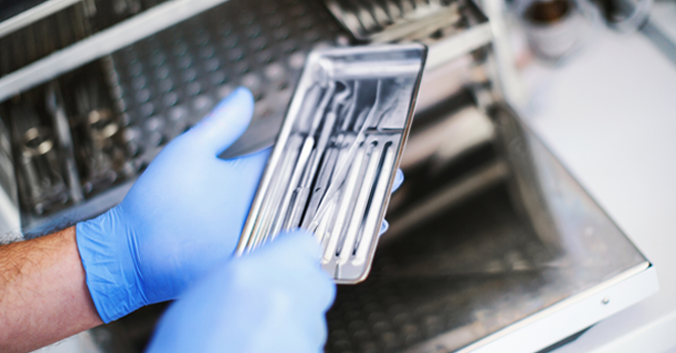
Spore test your sterilizers for quality assessment
Monitoring sterilizer functionality is crucial for every office. If your California-based practice has a quality assessment (QA) review coming up, you’ll want to be absolutely certain that you’re properly spore testing all sterilizers on a weekly basis. Improperly sterilized equipment is one of the most common reasons for QA non-compliance.
Spore testing, or biological monitoring, remains the best assurance that sterilization equipment is functioning and that your office is performing instrument processing procedures correctly. Spore testing assesses the killing of highly resistant Geobacillus and Bacillus spores. Inactivation of these microorganisms strongly implies that other potential pathogens in the load have been eliminated.
Here’s a checklist of important points to keep in mind to make sure your practice is safe and compliant when it comes to spore testing sterilizers.
Spore test all sterilizers
You must test all sterilizers present in your sterilization area. If a sterilizer is not currently being used, or is considered a back-up, it still must be spore tested at least weekly. To remain in compliance, store out of use or broken sterilizers away from the sterilization space in your practice if you are not conducting weekly spore testing on them.
Spore test at least once a week
California Code of Regulations states: “Proper functioning of the sterilization cycle of all sterilization devices shall be verified at least weekly through the use of a biological indicator (such as a spore test). Test results shall be documented and maintained for 12 months.”
In addition, the Centers for Disease Control and Prevention and the American Dental Association both recommend sterilizers be monitored at least weekly with biological indicators.
Retain records of spore testing for at least a year
With mail-in services, recordkeeping is done by the monitoring service. During a QA review, the examiner reviews records related to spore testing, so be sure to have them on hand for at least the past 12 months.
Remove any sterilizer with a positive test
If a positive test is reported on a sterilizer, immediately retest the sterilizer using the same cycle that produced the positive result. The sterilizer must be removed from service until you get a passing result from the retest. Most failed spore tests are due to operator error, so a passed retest confirms that the sterilizer is safe to use. Remember to document both the failed test and the passing retest in this scenario.
If the retest confirms a positive spore growth, then the sterilizer must remain out of service and all instruments that were sterilized by that machine must be recalled from use and re-sterilized through a different sterilizer to confirm that they are safe for patient care. The broken sterilizer must be inspected, repaired and re-challenged by passing three consecutive spore tests taken on three fully loaded cycles prior to returning the sterilizer to service.
During a QA review, it is not uncommon for an auditor to see failed spore testing results. A failed spore test will not cause a failure of the QA review so long as the office followed and documented the proper protocols after a failed spore test to ensure safe care for patients.
Do not substitute other forms of testing for spore tests
Spore testing is the standard for assuring proper sterilization of dental instruments. Mechanical or chemical indicators can help with the detection of procedural errors or malfunctions, but they do not verify sterility, and they do not replace the need for weekly spore test.
Recent posts
- Prepare your practice for back-to-school season
- Delta Dental is partnering with dental schools to offer exclusive CE courses
- Drive better patient experiences with benefit conversations
- Offer care beyond the chair with teledentistry
- Healthy mouths begin with hygienists
- How to educate patients and make them partners in oral health
- Dr. Justin Perdichizzi — serving those who served
- Get your patients to make (and keep) their dental appointments
- One sign-on, many advantages
- Delta Dental hosts in-person Provider Advisory Council in Arizona
